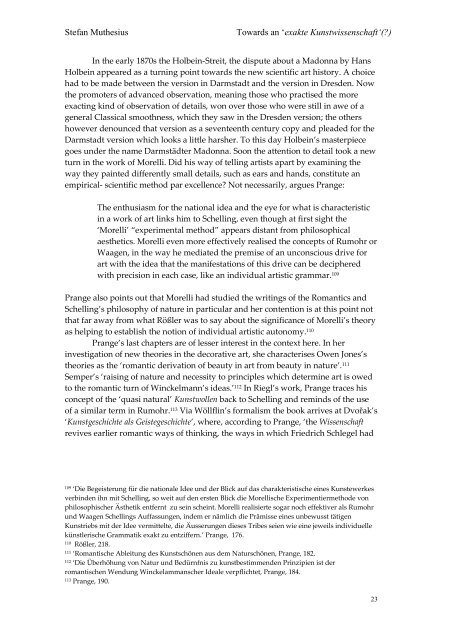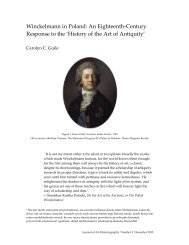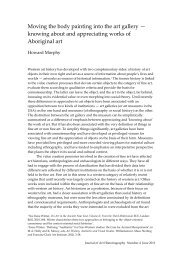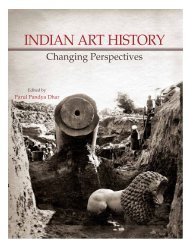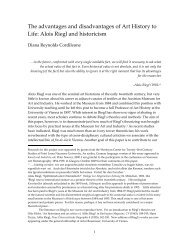9/SM1 - Journal of Art Historiography
9/SM1 - Journal of Art Historiography
9/SM1 - Journal of Art Historiography
You also want an ePaper? Increase the reach of your titles
YUMPU automatically turns print PDFs into web optimized ePapers that Google loves.
Stefan Muthesius<br />
Towards an ‘exakte Kunstwissenschaft‘(?)<br />
In the early 1870s the Holbein-Streit, the dispute about a Madonna by Hans<br />
Holbein appeared as a turning point towards the new scientific art history. A choice<br />
had to be made between the version in Darmstadt and the version in Dresden. Now<br />
the promoters <strong>of</strong> advanced observation, meaning those who practised the more<br />
exacting kind <strong>of</strong> observation <strong>of</strong> details, won over those who were still in awe <strong>of</strong> a<br />
general Classical smoothness, which they saw in the Dresden version; the others<br />
however denounced that version as a seventeenth century copy and pleaded for the<br />
Darmstadt version which looks a little harsher. To this day Holbein’s masterpiece<br />
goes under the name Darmstädter Madonna. Soon the attention to detail took a new<br />
turn in the work <strong>of</strong> Morelli. Did his way <strong>of</strong> telling artists apart by examining the<br />
way they painted differently small details, such as ears and hands, constitute an<br />
empirical- scientific method par excellence? Not necessarily, argues Prange:<br />
The enthusiasm for the national idea and the eye for what is characteristic<br />
in a work <strong>of</strong> art links him to Schelling, even though at first sight the<br />
‘Morelli’ “experimental method” appears distant from philosophical<br />
aesthetics. Morelli even more effectively realised the concepts <strong>of</strong> Rumohr or<br />
Waagen, in the way he mediated the premise <strong>of</strong> an unconscious drive for<br />
art with the idea that the manifestations <strong>of</strong> this drive can be deciphered<br />
with precision in each case, like an individual artistic grammar. 109<br />
Prange also points out that Morelli had studied the writings <strong>of</strong> the Romantics and<br />
Schelling’s philosophy <strong>of</strong> nature in particular and her contention is at this point not<br />
that far away from what Rößler was to say about the significance <strong>of</strong> Morelli’s theory<br />
as helping to establish the notion <strong>of</strong> individual artistic autonomy. 110<br />
Prange’s last chapters are <strong>of</strong> lesser interest in the context here. In her<br />
investigation <strong>of</strong> new theories in the decorative art, she characterises Owen Jones’s<br />
theories as the ‘romantic derivation <strong>of</strong> beauty in art from beauty in nature’. 111<br />
Semper’s ‘raising <strong>of</strong> nature and necessity to principles which determine art is owed<br />
to the romantic turn <strong>of</strong> Winckelmann’s ideas.’ 112 In Riegl’s work, Prange traces his<br />
concept <strong>of</strong> the ‘quasi natural’ Kunstwollen back to Schelling and reminds <strong>of</strong> the use<br />
<strong>of</strong> a similar term in Rumohr. 113 Via Wöllflin’s formalism the book arrives at Dvořak’s<br />
‘Kunstgeschichte als Geistegeschichte’, where, according to Prange, ‘the Wissenschaft<br />
revives earlier romantic ways <strong>of</strong> thinking, the ways in which Friedrich Schlegel had<br />
109<br />
‘Die Begeisterung für die nationale Idee und der Blick auf das charakteristische eines Kunstewerkes<br />
verbinden ihn mit Schelling, so weit auf den ersten Blick die Morellische Experimentiermethode von<br />
philosophischer Ästhetik entfernt zu sein scheint. Morelli realisierte sogar noch effektiver als Rumohr<br />
und Waagen Schellings Auffassungen, indem er nämlich die Prämisse eines unbewusst tätigen<br />
Kunstriebs mit der Idee vermittelte, die Äusserungen dieses Tribes seien wie eine jeweils individuelle<br />
künstlerische Grammatik exakt zu entziffern.’ Prange, 176.<br />
110<br />
Rößler, 218.<br />
111<br />
‘Romantische Ableitung des Kunstschönen aus dem Naturschönen, Prange, 182.<br />
112<br />
‘Die Überhöhung von Natur und Bedürnfnis zu kunstbestimmenden Prinzipien ist der<br />
romantischen Wendung Winckelammanscher Ideale verpflichtet, Prange, 184.<br />
113<br />
Prange, 190.<br />
23


